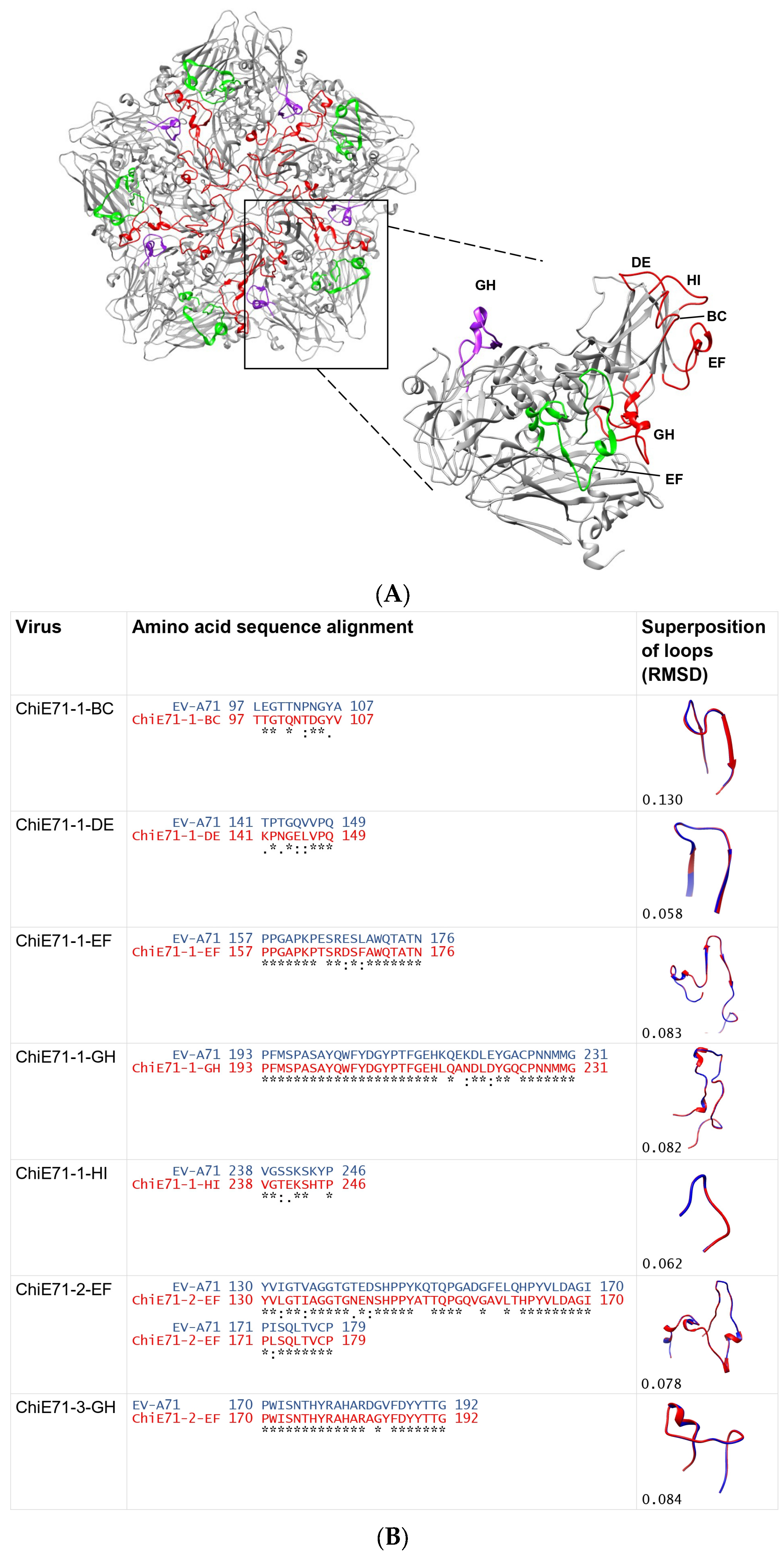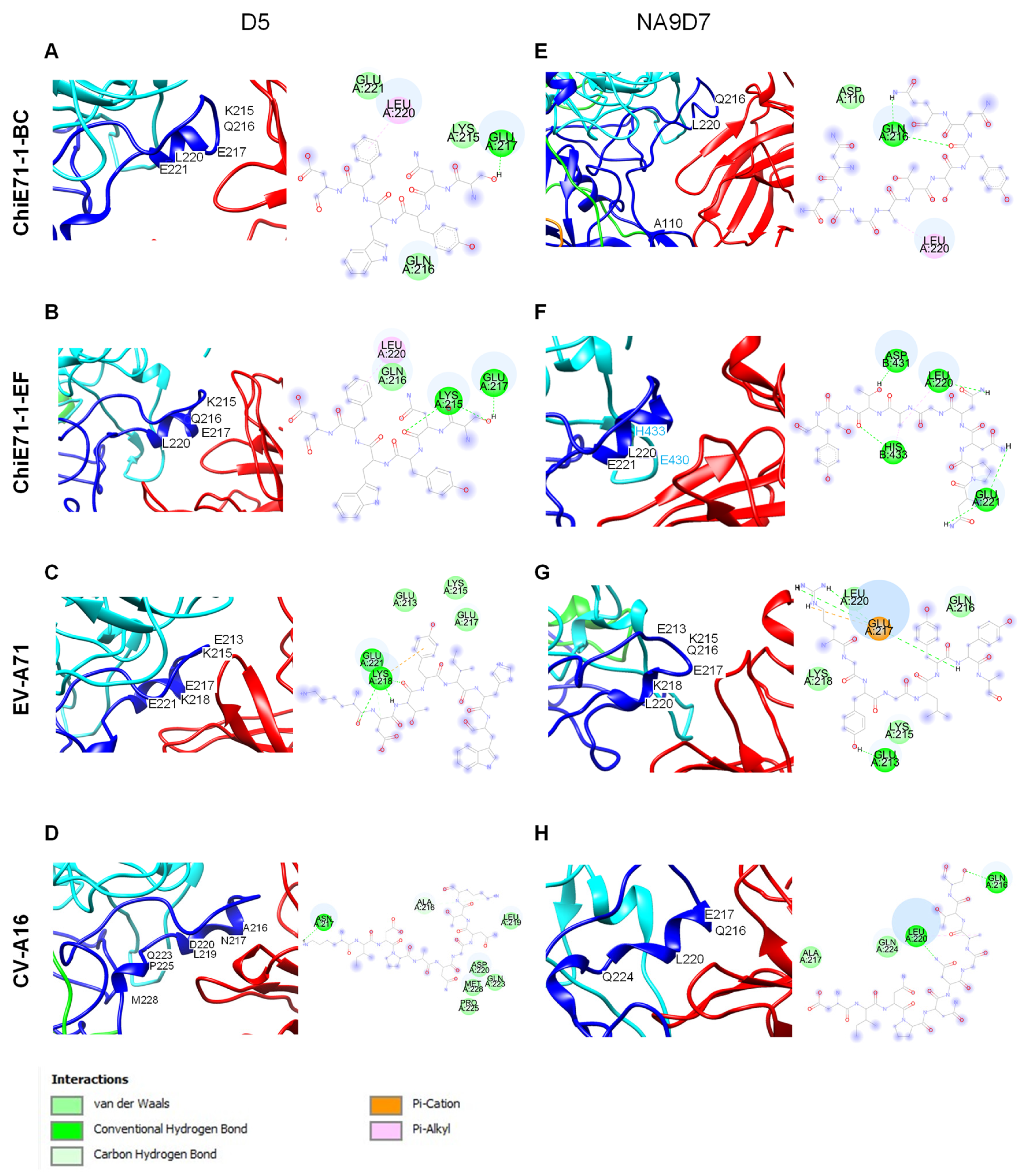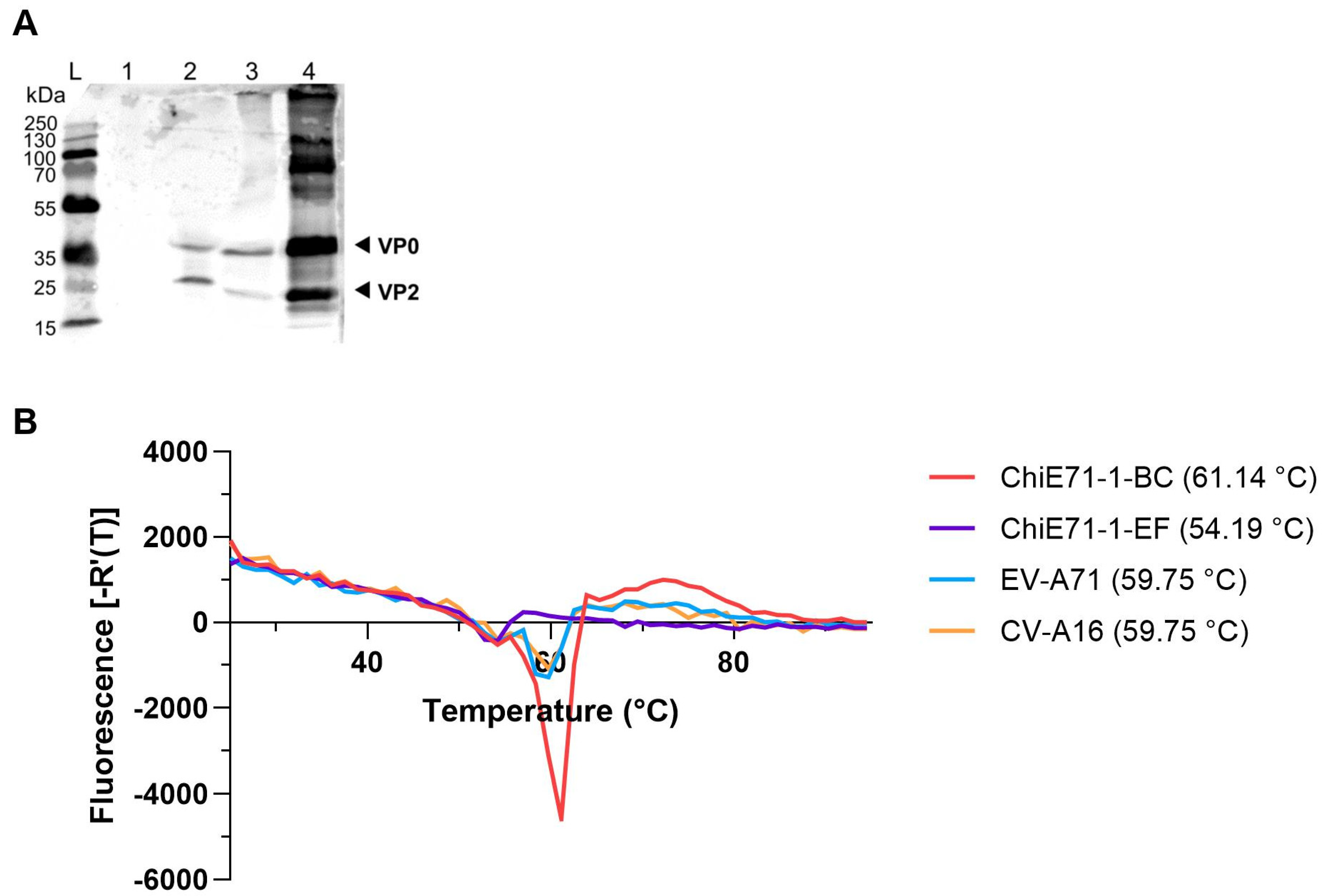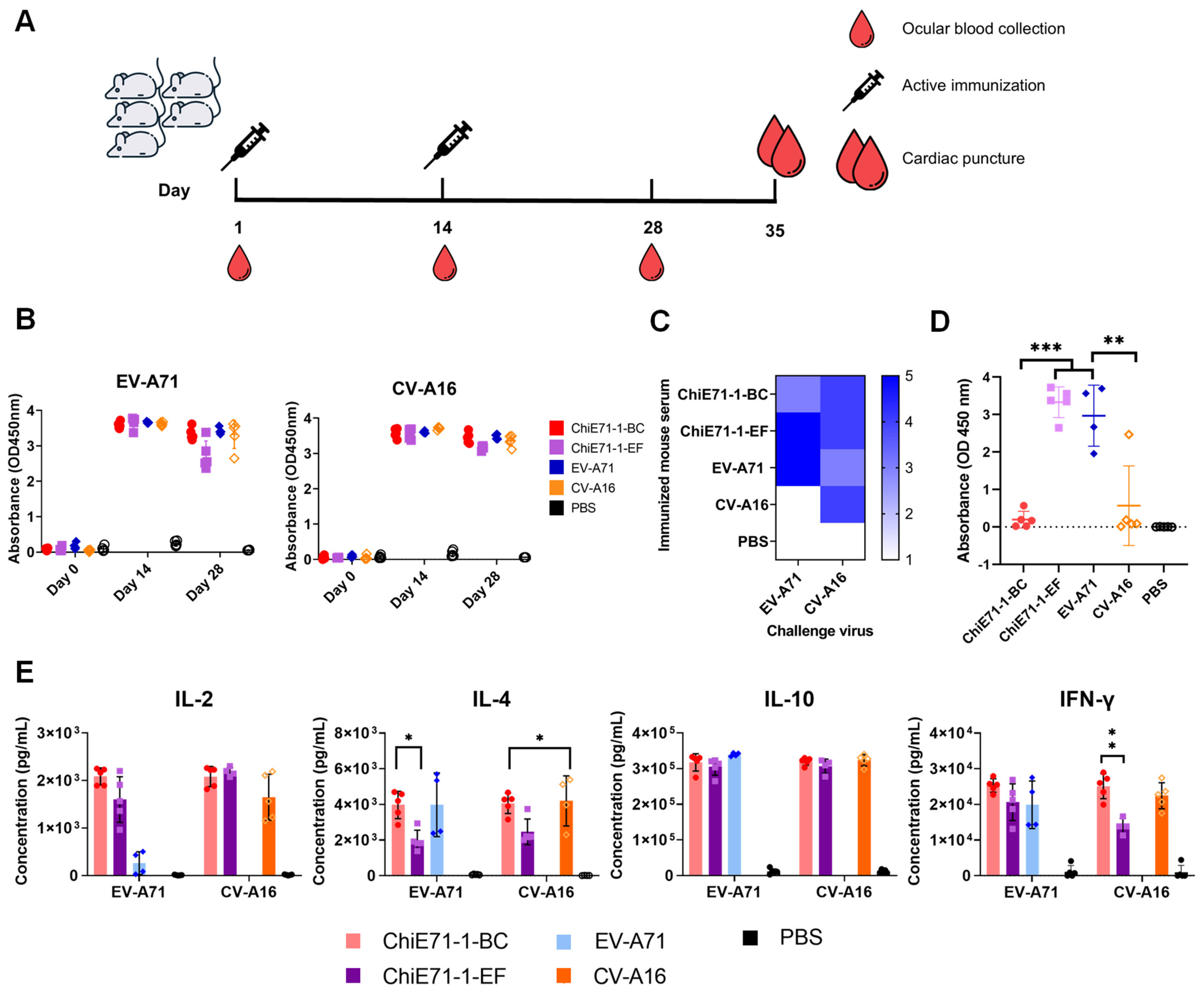Substitution of Coxsackievirus A16 VP1 BC and EF Loop Altered the Protective Immune Responses in Chimera Enterovirus A71
Abstract
1. Introduction
2. Materials and Methods
2.1. Cells and Plasmids
2.2. Mice
2.3. Construction of Chimera Infections Clones and Virus
2.4. One-Step Growth Curve and Plaque Morphology
2.5. Viruses
2.6. Immunization of Adult Mice and Passive Transfer of Anti-ChiE71 Sera
2.7. Active Immunization in Neonatal Mice
2.8. Virus Neutralization Assay
2.9. Whole-Virus and Protein VP1 ELISA for IgG Detection
2.10. Splenocyte Isolation and Th1/Th2 Cytokine Assay
2.11. Thermal Stability of ChiE71
2.12. Molecular Modeling
2.13. Statistical Analysis
3. Results
3.1. Construction of ChiE71 and Structural Modeling
3.2. Growth Characteristics of ChiE71
3.3. Neutralization Capacity of Human Antisera against ChiE71
3.4. Protein–Protein Interactions between ChiE71 and EV-A71 and CV-A16 Antibodies
3.5. Thermal Stability of ChiE71
3.6. ChiE71 Induces Humoral Immune Responses against Both EV-A71 and CV-A16
3.7. ChiE71 Induce Cellular Immune Responses against EV-A71 and CV-A16
3.8. Passive Transfer of Chi-E71-Immunized Mouse Sera
3.9. Active Immunization of ChiE71 in Neonatal Mice
4. Discussion
Supplementary Materials
Author Contributions
Funding
Institutional Review Board Statement
Informed Consent Statement
Data Availability Statement
Conflicts of Interest
References
- Chiu, M.L.; Luo, S.T.; Chen, Y.Y.; Chung, W.Y.; Duong, V.; Dussart, P.; Chan, Y.F.; Perera, D.; Ooi, M.H.; Thao, N.T.T. Establishment of Asia-Pacific network for enterovirus surveillance. J. Vaccine 2020, 38, 1–9. [Google Scholar] [CrossRef] [PubMed]
- Lee, M.H.P.; Chong, Y.M.; Tay, C.G.; Koh, M.T.; Chem, Y.K.; Noordin, N.; Jahis, R.; Sam, I.C.; Chan, Y.F. Detection of enteroviruses during a 2018 hand, foot and mouth disease outbreak in Malaysia. Trop. Biomed. 2021, 38, 150–153. [Google Scholar] [CrossRef] [PubMed]
- Chan, Y.F.; Wee, K.L.; Chiam, C.W.; Khor, C.S.; Chan, S.Y.; Amalina, W.M.; Sam, I.C. Comparative genetic analysis of VP4, VP1 and 3D gene regions of enterovirus 71 and coxsackievirus A16 circulating in Malaysia between 1997–2008. Trop. Biomed. 2012, 29, 451–466. [Google Scholar] [PubMed]
- NikNadia, N.M.N.; Sam, I.C.; Rampal, S.; WanNorAmalina, W.M.Z.; NurAtifah, G.; Verasahib, K.; Ong, C.C.; MohdAdib, M.; Chan, Y.F. Cyclical patterns of hand, foot and mouth disease caused by enterovirus A71 in Malaysia. PLoS Negl. Trop. Dis. 2016, 10, e0004562. [Google Scholar] [CrossRef] [PubMed]
- Ooi, M.H.; Wong, S.C.; Lewthwaite, P.; Cardosa, M.J.; Solomon, T. Clinical features, diagnosis, and management of enterovirus 71. Lancet Neurol. 2010, 9, 1097–1105. [Google Scholar] [CrossRef]
- Jiang, P.; Liu, Y.; Ma, H.-C.; Paul, A.V.; Wimmer, E. Picornavirus morphogenesis. Microbiol. Mol. Biol. Rev. 2014, 78, 418–437. [Google Scholar] [CrossRef]
- Aw-Yong, K.L.; Sam, I.C.; Koh, M.T.; Chan, Y.F. Immunodominant IgM and IgG epitopes recognized by antibodies induced in enterovirus A71-associated hand, foot and mouth disease patients. PLoS ONE 2016, 11, e0165659. [Google Scholar] [CrossRef]
- Minor, P.D.; Ferguson, M.; Evans, D.M.; Almond, J.W.; Icenogle, J.P. Antigenic structure of polioviruses of serotypes 1, 2 and 3. J. Gen. Virol. 1986, 67 Pt 7, 1283–1291. [Google Scholar] [CrossRef]
- Fox, H.; Knowlson, S.; Minor, P.D.; Macadam, A.J. Genetically Thermo-Stabilised, Immunogenic Poliovirus Empty Capsids; a Strategy for Non-replicating Vaccines. PLoS Pathog. 2017, 13, e1006117. [Google Scholar] [CrossRef]
- Bahar, M.W.; Porta, C.; Fox, H.; Macadam, A.J.; Fry, E.E.; Stuart, D.I. Mammalian expression of virus-like particles as a proof of principle for next generation polio vaccines. Npj Vaccines 2021, 6, 5. [Google Scholar] [CrossRef]
- Foo, D.G.W.; Alonso, S.; Phoon, M.C.; Ramachandran, N.P.; Chow, V.T.K.; Poh, C.L. Identification of neutralizing linear epitopes from the VP1 capsid protein of Enterovirus 71 using synthetic peptides. Virus Res. 2007, 125, 61–68. [Google Scholar] [CrossRef] [PubMed]
- Liu, C.C.; Chou, A.H.; Lien, S.P.; Lin, H.Y.; Liu, S.J.; Chang, J.Y.; Guo, M.S.; Chow, Y.H.; Yang, W.S.; Chang, K.H.; et al. Identification and characterization of a cross-neutralization epitope of enterovirus 71. Vaccine 2011, 29, 4362–4372. [Google Scholar] [CrossRef]
- Anasir, M.I.; Poh, C.L. Advances in antigenic peptide-based vaccine and neutralizing antibodies against viruses causing hand, foot, and mouth disease. Int. J. Mol. Sci. 2019, 20, 1256. [Google Scholar] [CrossRef] [PubMed]
- Murdin, A.D.; Wimmer, E. Construction of a poliovirus type 1/type 2 antigenic hybrid by manipulation of neutralization antigenic site II. J. Virol. 1989, 63, 5251–5257. [Google Scholar] [CrossRef] [PubMed]
- Lee, M.H.P.; Tan, C.W.; Tee, H.K.; Ong, K.C.; Sam, I.C.; Chan, Y.F. Vaccine candidates generated by codon and codon pair deoptimization of enterovirus A71 protect against lethal challenge in mice. Vaccine 2021, 39, 1708–1720. [Google Scholar] [CrossRef]
- Tee, H.K.; Tan, C.W.; Yogarajah, T.; Lee, M.H.P.; Chai, H.J.; Hanapi, N.A.; Yusof, S.R.; Ong, K.C.; Lee, V.S.; Sam, I.C.; et al. Electrostatic interactions at the five-fold axis alter heparin-binding phenotype and drive enterovirus A71 virulence in mice. PLoS Pathog. 2019, 15, e1007863. [Google Scholar] [CrossRef] [PubMed]
- Evans, D.J.; McKeating, J.; Meredith, J.M.; Burke, K.L.; Katrak, K.; John, A.; Ferguson, M.; Minor, P.D.; Weiss, R.A.; Almond, J.W. An engineered poliovirus chimaera elicits broadly reactive HIV-1 neutralizing antibodies. Nature 1989, 339, 385–388. [Google Scholar] [CrossRef]
- Colbère-Garapin, F.; Christodoulou, C.; Crainic, R.; Garapin, A.-C.; Candrea, A. Addition of a foreign oligopeptide to the major capsid protein of poliovirus. Proc. Natl. Acad. Sci. USA 1988, 85, 8668–8672. [Google Scholar] [CrossRef]
- Tan, C.W.; Tee, H.K.; Lee, M.H.P.; Sam, I.C.; Chan, Y.F. Enterovirus A71 DNA-launched infectious clone as a robust reverse genetic tool. PLoS ONE 2016, 11, e0162771. [Google Scholar] [CrossRef]
- Ong, K.C.; Devi, S.; Cardosa, M.J.; Wong, K.T. Formaldehyde-Inactivated Whole-Virus Vaccine Protects a Murine Model of Enterovirus 71 Encephalomyelitis against Disease. J. Virol. 2010, 84, 661–665. [Google Scholar] [CrossRef]
- Liu, C.-C.; Guo, M.-S.; Lin, F.H.-Y.; Hsiao, K.-N.; Chang, K.H.-W.; Chou, A.-H.; Wang, Y.-C.; Chen, Y.-C.; Yang, C.-S.; Chong, P.C.-S. Purification and Characterization of Enterovirus 71 Viral Particles Produced from Vero Cells Grown in a Serum-Free Microcarrier Bioreactor System. PLoS ONE 2011, 6, e20005. [Google Scholar] [CrossRef]
- Walter, T.S.; Ren, J.; Tuthill, T.J.; Rowlands, D.J.; Stuart, D.I.; Fry, E.E. A plate-based high-throughput assay for virus stability and vaccine formulation. J. Virol. Methods 2012, 185, 166–170. [Google Scholar] [CrossRef] [PubMed]
- Waterhouse, A.; Bertoni, M.; Bienert, S.; Studer, G.; Tauriello, G.; Gumienny, R.; Heer, F.T.; de Beer, T.A.P.; Rempfer, C.; Bordoli, L.; et al. SWISS-MODEL: Homology modelling of protein structures and complexes. Nucleic Acids Res. 2018, 46, W296–W303. [Google Scholar] [CrossRef] [PubMed]
- Jurrus, E.; Engel, D.; Star, K.; Monson, K.; Brandi, J.; Felberg, L.E.; Brookes, D.H.; Wilson, L.; Chen, J.; Liles, K.; et al. Improvements to the APBS biomolecular solvation software suite. Protein Sci. 2018, 27, 112–128. [Google Scholar] [CrossRef]
- Roe, D.R.; Cheatham, T.E. PTRAJ and CPPTRAJ: Software for processing and analysis of molecular dynamics trajectory data. J. Chem. Theory Comput. 2013, 9, 3084–3095. [Google Scholar] [CrossRef]
- Ye, X.; Fan, C.; Ku, Z.; Zuo, T.; Kong, L.; Zhang, C.; Shi, J.; Liu, Q.; Chen, T.; Zhang, Y.; et al. Structural basis for recognition of human enterovirus 71 by a bivalent broadly neutralizing monoclonal antibody. PLoS Pathog. 2016, 12, e1005454. [Google Scholar] [CrossRef]
- He, M.; Xu, L.; Zheng, Q.; Zhu, R.; Yin, Z.; Zha, Z.; Lin, Y.; Yang, L.; Huang, Y.; Ye, X.; et al. Identification of antibodies with non-overlapping neutralization sites that target coxsackievirus A16. Cell Host Microbe 2020, 27, 249–261.e245. [Google Scholar] [CrossRef] [PubMed]
- van Zundert, G.C.P.; Rodrigues, J.; Trellet, M.; Schmitz, C.; Kastritis, P.L.; Karaca, E.; Melquiond, A.S.J.; van Dijk, M.; de Vries, S.J.; Bonvin, A. The HADDOCK2.2 web server: User-friendly integrative modeling of biomolecular complexes. J. Mol. Biol. 2016, 428, 720–725. [Google Scholar] [CrossRef]
- de Vries, S.J.; van Dijk, M.; Bonvin, A.M. The HADDOCK web server for data-driven biomolecular docking. Nat. Protoc. 2010, 5, 883–897. [Google Scholar] [CrossRef]
- Pettersen, E.F.; Goddard, T.D.; Huang, C.C.; Couch, G.S.; Greenblatt, D.M.; Meng, E.C.; Ferrin, T.E. UCSF Chimera--a visualization system for exploratory research and analysis. J. Comput. Chem. 2004, 25, 1605–1612. [Google Scholar] [CrossRef]
- Huang, Y.-L.; Lin, T.-M.; Wang, S.-Y.; Wang, J.-R. The role of conserved arginine and proline residues in enterovirus VP1 protein. J. Microbiol. Immunol. Infect. 2022, 55, 590–597. [Google Scholar] [CrossRef] [PubMed]
- Ku, Z.; Ye, X.; Shi, J.; Wang, X.; Liu, Q.; Huang, Z.; López, S. Single neutralizing monoclonal antibodies targeting the VP1 GH loop of enterovirus 71 inhibit both virus attachment and internalization during viral entry. J. Virol. 2015, 89, 12084–12095. [Google Scholar] [CrossRef] [PubMed]
- Ye, X.; Ku, Z.; Liu, Q.; Wang, X.; Shi, J.; Zhang, Y.; Kong, L.; Cong, Y.; Huang, Z. Chimeric virus-like particle vaccines displaying conserved enterovirus 71 epitopes elicit protective neutralizing antibodies in mice through divergent mechanisms. J. Virol. 2014, 88, 72–81. [Google Scholar] [CrossRef] [PubMed]
- Catching, A.; Yeh, M.T.; Bianco, S.; Capponi, S.; Andino, R. A tradeoff between enterovirus A71 particle stability and cell entry. bioRxiv 2022. [Google Scholar] [CrossRef]
- Huang, Y.-L.; Huang, S.-W.; Shen, C.-Y.; Cheng, D.; Wang, J.-R. Conserved Residues Adjacent to ß-Barrel and Loop Intersection among Enterovirus VP1 Affect Viral Replication: Potential Target for Anti-Enteroviral Development. Viruses 2022, 14, 364. [Google Scholar] [CrossRef]
- Kingston, N.J.; Shegdar, M.; Snowden, J.S.; Fox, H.; Groppelli, E.; Macadam, A.; Rowlands, D.J.; Stonehouse, N.J. Thermal stabilization of enterovirus A 71 and production of antigenically stabilized empty capsids. J. Gen. Virol. 2022, 103, 001771. [Google Scholar] [CrossRef]
- Teilum, K.; Olsen, J.G.; Kragelund, B.B. Functional aspects of protein flexibility. Cell Mol. Life Sci. 2009, 66, 2231–2247. [Google Scholar] [CrossRef]
- Cordey, S.; Petty, T.J.; Schibler, M.; Martinez, Y.; Gerlach, D.; van Belle, S.; Turin, L.; Zdobnov, E.; Kaiser, L.; Tapparel, C. Identification of site-specific adaptations conferring increased neural cell tropism during human enterovirus 71 infection. PLoS Pathog. 2012, 8, e1002826. [Google Scholar] [CrossRef]
- Zaini, Z.; Phuektes, P.; McMinn, P. Mouse adaptation of a sub-genogroup B5 strain of human enterovirus 71 is associated with a novel lysine to glutamic acid substitution at position 244 in protein VP1. Virus Res. 2012, 167, 86–96. [Google Scholar] [CrossRef]
- Lu, H.H.; Yang, C.F.; Murdin, A.D.; Klein, M.H.; Harber, J.J.; Kew, O.M.; Wimmer, E. Mouse neurovirulence determinants of poliovirus type 1 strain LS-a map to the coding regions of capsid protein VP1 and proteinase 2Apro. J. Virol. 1994, 68, 7507–7515. [Google Scholar] [CrossRef]
- Murray, M.G.; Bradley, J.; Yang, X.F.; Wimmer, E.; Moss, E.G.; Racaniello, V.R. Poliovirus host range is determined by a short amino acid sequence in neutralization antigenic site I. Science 1988, 241, 213–215. [Google Scholar] [CrossRef] [PubMed]
- Moss, E.G.; Racaniello, V.R. Host range determinants located on the interior of the poliovirus capsid. EMBO J. 1991, 10, 1067–1074. [Google Scholar] [CrossRef] [PubMed]
- Shi, J.; Huang, X.; Liu, Q.; Huang, Z. Identification of conserved neutralizing linear epitopes within the VP1 protein of coxsackievirus A16. Vaccine 2013, 31, 2130–2136. [Google Scholar] [CrossRef]
- Chou, A.H.; Liu, C.C.; Chang, J.Y.; Lien, S.P.; Guo, M.S.; Tasi, H.P.; Hsiao, K.N.; Liu, S.J.; Sia, C.; Wu, S.C.; et al. Immunological evaluation and comparison of different EV71 vaccine candidates. Clin. Dev. Immunol. 2012, 2012, 831282. [Google Scholar] [CrossRef]
- Chou, A.H.; Liu, C.C.; Chang, J.Y.; Jiang, R.; Hsieh, Y.C.; Tsao, A.; Wu, C.L.; Huang, J.L.; Fung, C.P.; Hsieh, S.M.; et al. Formalin-inactivated EV71 vaccine candidate induced cross-neutralizing antibody against subgenotypes B1, B4, B5 and C4a in adult volunteers. PLoS ONE 2013, 8, e79783. [Google Scholar] [CrossRef]
- Imura, A.; Sudaka, Y.; Takashino, A.; Tamura, K.; Kobayashi, K.; Nagata, N.; Nishimura, H.; Mizuta, K.; Koike, S. Development of an Enterovirus 71 Vaccine Efficacy Test Using Human Scavenger Receptor B2 Transgenic Mice. J. Virol. 2020, 94, e01921-19. [Google Scholar] [CrossRef]
- Hong, J.; Liu, F.; Qi, H.; Tu, W.; Ward, M.P.; Ren, M.; Zhao, Z.; Su, Q.; Huang, J.; Chen, X.; et al. Changing epidemiology of hand, foot, and mouth disease in China, 2013-2019: A population-based study. Lancet Reg. Health West. Pac. 2022, 20, 100370. [Google Scholar] [CrossRef] [PubMed]
- Yang, T.; Xie, T.; Song, X.; Shen, D.; Li, H.; Yue, L.; Jiang, Q.; Zhu, F.; Meng, H.; Long, R.; et al. Safety and immunogenicity of an experimental live combination vaccine against enterovirus 71 and coxsackievirus A16 in rhesus monkeys. Hum. Vaccines Immunother. 2020, 16, 1586–1594. [Google Scholar] [CrossRef]
- Sun, S.; Jiang, L.; Liang, Z.; Mao, Q.; Su, W.; Zhang, H.; Li, X.; Jin, J.; Xu, L.; Zhao, D.; et al. Evaluation of monovalent and bivalent vaccines against lethal enterovirus 71 and eoxsackievirus A16 infection in newborn mice. Hum. Vaccines Immunother. 2014, 10, 2885–2895. [Google Scholar] [CrossRef]
- Cai, Y.; Ku, Z.; Liu, Q.; Leng, Q.; Huang, Z. A combination vaccine comprising of inactivated enterovirus 71 and coxsackievirus A16 elicits balanced protective immunity against both viruses. Vaccine 2014, 32, 2406–2412. [Google Scholar] [CrossRef]
- Ku, Z.; Liu, Q.; Ye, X.; Cai, Y.; Wang, X.; Shi, J.; Li, D.; Jin, X.; An, W.; Huang, Z. A virus-like particle based bivalent vaccine confers dual protection against enterovirus 71 and coxsackievirus A16 infections in mice. Vaccine 2014, 32, 4296–4303. [Google Scholar] [CrossRef] [PubMed]
- Li, X.F.; Deng, Y.Q.; Yang, H.Q.; Zhao, H.; Jiang, T.; Yu, X.D.; Li, S.H.; Ye, Q.; Zhu, S.Y.; Wang, H.J.; et al. A chimeric dengue virus vaccine using Japanese encephalitis virus vaccine strain SA14-14-2 as backbone is immunogenic and protective against either parental virus in mice and nonhuman primates. J. Virol. 2013, 87, 13694–13705. [Google Scholar] [CrossRef] [PubMed]
- Huang, C.Y.; Butrapet, S.; Tsuchiya, K.R.; Bhamarapravati, N.; Gubler, D.J.; Kinney, R.M. Dengue 2 PDK-53 virus as a chimeric carrier for tetravalent dengue vaccine development. J. Virol. 2003, 77, 11436–11447. [Google Scholar] [CrossRef]
- Guirakhoo, F.; Pugachev, K.; Zhang, Z.; Myers, G.; Levenbook, I.; Draper, K.; Lang, J.; Ocran, S.; Mitchell, F.; Parsons, M.; et al. Safety and efficacy of chimeric yellow fever-dengue virus tetravalent vaccine formulations in nonhuman primates. J. Virol. 2004, 78, 4761–4775. [Google Scholar] [CrossRef] [PubMed]
- Wang, X.; Peng, W.; Ren, J.; Hu, Z.; Xu, J.; Lou, Z.; Li, X.; Yin, W.; Shen, X.; Porta, C.; et al. A sensor-adaptor mechanism for enterovirus uncoating from structures of EV71. Nat. Struct. Mol. Biol. 2012, 19, 424–429. [Google Scholar] [CrossRef] [PubMed]
- Yamayoshi, S.; Iizuka, S.; Yamashita, T.; Minagawa, H.; Mizuta, K.; Okamoto, M.; Nishimura, H.; Sanjoh, K.; Katsushima, N.; Itagaki, T.; et al. Human SCARB2-dependent infection by coxsackievirus A7, A14, and A16 and enterovirus 71. J. Virol. 2012, 86, 5686–5696. [Google Scholar] [CrossRef]
- Luo, J.; Huo, C.; Qin, H.; Hu, J.; Lei, L.; Pan, Z. Chimeric enterovirus 71 virus-like particle displaying conserved coxsackievirus A16 epitopes elicits potent immune responses and protects mice against lethal EV71 and CA16 infection. Vaccine 2021, 39, 4135–4143. [Google Scholar] [CrossRef]
- Xu, L.; He, D.; Li, Z.; Zheng, J.; Yang, L.; Yu, M.; Yu, H.; Chen, Y.; Que, Y.; Shih, J.W.; et al. Protection against lethal enterovirus 71 challenge in mice by a recombinant vaccine candidate containing a broadly cross-neutralizing epitope within the VP2 EF loop. Theranostics 2014, 4, 498–513. [Google Scholar] [CrossRef]
- Xu, L.; He, D.; Yang, L.; Li, Z.; Ye, X.; Yu, H.; Zhao, H.; Li, S.; Yuan, L.; Qian, H.; et al. A broadly cross-protective vaccine presenting the neighboring epitopes within the VP1 GH Loop and VP2 EF loop of enterovirus 71. Sci. Rep. 2015, 5, 12973. [Google Scholar] [CrossRef]
- Gromeier, M.; Nair, S.K. Recombinant poliovirus for cancer immunotherapy. Annu. Rev. Med. 2018, 69, 289–299. [Google Scholar] [CrossRef]
- Mosaheb, M.M.; Dobrikova, E.Y.; Brown, M.C.; Yang, Y.; Cable, J.; Okada, H.; Nair, S.K.; Bigner, D.D.; Ashley, D.M.; Gromeier, M. Genetically stable poliovirus vectors activate dendritic cells and prime antitumor CD8 T cell immunity. Nat. Commun. 2020, 11, 524. [Google Scholar] [CrossRef] [PubMed]







Disclaimer/Publisher’s Note: The statements, opinions and data contained in all publications are solely those of the individual author(s) and contributor(s) and not of MDPI and/or the editor(s). MDPI and/or the editor(s) disclaim responsibility for any injury to people or property resulting from any ideas, methods, instructions or products referred to in the content. |
© 2023 by the authors. Licensee MDPI, Basel, Switzerland. This article is an open access article distributed under the terms and conditions of the Creative Commons Attribution (CC BY) license (https://creativecommons.org/licenses/by/4.0/).
Share and Cite
Tan, X.H.; Chong, W.L.; Lee, V.S.; Abdullah, S.; Jasni, K.; Suarni, S.Q.; Perera, D.; Sam, I.-C.; Chan, Y.F. Substitution of Coxsackievirus A16 VP1 BC and EF Loop Altered the Protective Immune Responses in Chimera Enterovirus A71. Vaccines 2023, 11, 1363. https://doi.org/10.3390/vaccines11081363
Tan XH, Chong WL, Lee VS, Abdullah S, Jasni K, Suarni SQ, Perera D, Sam I-C, Chan YF. Substitution of Coxsackievirus A16 VP1 BC and EF Loop Altered the Protective Immune Responses in Chimera Enterovirus A71. Vaccines. 2023; 11(8):1363. https://doi.org/10.3390/vaccines11081363
Chicago/Turabian StyleTan, Xiu Hui, Wei Lim Chong, Vannajan Sanghiran Lee, Syahril Abdullah, Kartini Jasni, Saiful Qushairi Suarni, David Perera, I-Ching Sam, and Yoke Fun Chan. 2023. "Substitution of Coxsackievirus A16 VP1 BC and EF Loop Altered the Protective Immune Responses in Chimera Enterovirus A71" Vaccines 11, no. 8: 1363. https://doi.org/10.3390/vaccines11081363
APA StyleTan, X. H., Chong, W. L., Lee, V. S., Abdullah, S., Jasni, K., Suarni, S. Q., Perera, D., Sam, I.-C., & Chan, Y. F. (2023). Substitution of Coxsackievirus A16 VP1 BC and EF Loop Altered the Protective Immune Responses in Chimera Enterovirus A71. Vaccines, 11(8), 1363. https://doi.org/10.3390/vaccines11081363





